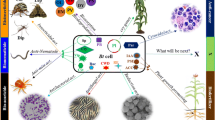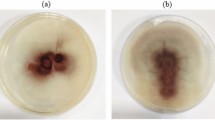Abstract
A new cry1Ab gene was cloned from the promising local isolate, DOR Bt-1, a Bacillus thuringiensis strain isolated from castor semilooper (Achaea janata L.) cadavers from castor bean (Ricinus communis L.) field. The nucleotide sequence of the cloned cry1Ab gene indicated that the open reading frame consisted of 3,465 bases encoding a protein of 1,155 amino acid residues with an estimated molecular weight of 130 kDa. Homology comparisons revealed that the deduced amino acid sequence of cry1Ab had a variation of seven amino acid residues compared to those of the known Cry1Ab proteins in the NCBI database and this gene has been designated as cry1Ab26 by the B. thuringiensis δ-endotoxin Nomenclature Committee. cry1Ab26 was cloned into pET 29a(+) vector and expressed in E. coli strain BL21 (DE3) under the control of T7 promoter with IPTG induction. ELISA, SDS-PAGE, and Western blot analysis confirmed the expression of 130-kDa protein. Insect bioassays with neonate larvae of Helicoverpa armigera showed that the partially purified Cry1Ab26 caused 97 % mortality within 5 days of feeding.



Similar content being viewed by others
References
Bravo, A., Gill, S. S., & Soberon, M. (2007). Mode of action of Bacillus thuringiensis Cry and Cyt toxins and their potential for insect control. Toxicon, 49, 423–435.
Crickmore, N. (2011). http://www.biols.susx.ac.uk/Home/Neil_Crickmore/Bt/index.html
Bravo, A., Likitvivatanauong, S., Gill, S. S., & Soberon, M. (2011). Bacillus thuringiensis: A story of successful bioinsecticide. Insect Biochemistry and Molecular Biology, 41(7), 423–431.
Tiewsiri, K., & Wang, P. (2011). Differential alteration of two aminopeptidases N associated with resistance to Bacillus thuringiensis toxin Cry1ac in cabbage looper. PNAS, 108(34), 14037–14042.
Heckel, D. G., Gahan, L. J., Baxter, S. W., Zhao, J. Z., Shelton, A. M., Gould, F., et al. (2007). The diversity of Bt resistance gene in species of Lepidoptera. Journal of Invertebrate Pathology, 95, 192–197.
Gomez, I., Arenas, I., Benitez, I., Miranda-Rios, J., Becerril, B., Grande, R., et al. (2006). Specific epitopes of domains II and III of Bacillus thuringensis cry1Ab toxin involved in the sequential interaction with cadherin and aminopeptidase-N receptors in Manduca sexta. The Journal of Biological Chemistry, 281(45), 34032–34039.
Ferre, J., & Van Rie, J. (2002). Biochemistry and genetics of insect resistance to Bacillus thuringiensis. Annual Review of Entomology, 47, 501–533.
Morin, S., Biggs, R. W., Sisterson, M. S., Shriver, L., Ellers-Kirk, C., Higginson, D., et al. (2003). Three cadherin alleles associated with resistance to Bacillus thuringiensis in pink bollworm. Proceedings of the National Academy of Sciences USA, 100, 5004–5009.
Xu, X., Yu, L., & Wu, Y. (2005). Disruption of a cadharin gene associated with resistance to cry1Ab δ-endotoxin of Bacillus thuringensis in Helicoverpa armigera. Applied and Environmental Microbiology, 71, 948–954.
Soberon, M., Pardo-Lopez, L., Lopez, I., Gomez, I., Tabashnik, B. E., & Bravo, A. (2007). Engineering modified Bt toxins to counter insect resistance. Science, 318, 1640–1642.
Pardo-Lopez, L., Tabashnik, B. E., Soberon-Chavez, M., & Bravo-De, L. M. (2010). Suppression of resistance in insects to Bacillus thurigensis cry toxins, using toxins that do not require the Cadherin Receptor. Patent application publication US 0186123A1.
Saraswathy, N., & Kumar, P. A. (2004). Protein engineering of δ-endotoxins of Bacillus thuringiensis. Electronic Journal of Biotechnology, 7, 180–190.
Nair, M. S., & Dean, D. H. (2008). All domains of Cry1A toxins insert into insect brush border membranes. Journal of Biological Chemistry, 283, 26324–26331.
Tounsi, S., J’Mal, A., Zouari, N., & Jaoua, S. (1999). Cloning and nucleotide sequence of a novel cry1Aa-type gene from Bacillus thuringiensis ssp. kurstaki. Biotechnology Letters, 21, 771–775.
Gatehouse, J. A. (2008). Biotechnological prospects for engineering insect-resistant plants. Plant Physiology, 146, 881–887.
Stobdan, T., Kaur, S., & Singh, A. (2004). Cloning and nucleotide sequence of a novel cry gene from Bacillus thuringiensis. Biotechnology Letters, 26, 1153–1156.
Sanahuja, G., Banakar, R., Twyman, R. M., Capeel, T., & Christou, P. (2011). Bacillus thuringiensis: A century of research, development of commercial applications. Plant Biotechnology Journal, 9, 283–300.
Chakrabarti, S. K., Mandaokar, A. D., Shukla, A., Pattanayak, D., Naik, P. S., & Kumar, P. A. (2000). Bacillus thuringiensis Cry1Ab confers resistance to potato against Helicoverpa armigera (Hubner). Potato Research, 43, 143–152.
Subramanian, S., & Mohankumar, S. (2006). Genetic variability of the bollworm, Helicoverpa armigera occurring on different host plants. Journal of Insect Science, 6, 1–8.
Rajamohan, F., Alzate, O., Contrill, J. A., Curtiss, A., & Dean, D. H. (1996). Protein engineering of Bacillus thuringiensis delta-endotoxin: mutations at domain II of cry1Ab enhance receptor affinity and toxicity toward gypsy moth larvae. Proceedings of the National Academy of Sciences USA, 93, 14338–14343.
Vaughn, T., Cavato, T., Brar, G., Coombe, T., DeGooyer, T., Ford, S., et al. (2005). A method of controlling corn rootworm feeding using a Bacillus thuringiensis protein expressed in transgenic maize. Crop Science, 45, 931–938.
Xue, J., Gemei, L., Neil, C., Haitao, L., Kanglai, H., Fuping, S., et al. (2008). Cloning and characterization of a novel cry1A toxin from Bacillus thuringiensis with high toxicity to the Asian corn borer and other lepidopteran insects. FEMS Microbiology Letters, 280, 95–101.
Darsi, S., Divya, Prakash. G., & Udayasuriyan, V. (2010). Cloning and characterization of truncated cry1Ab gene from a new indigenous isolate of Bacillus thuringiensis. Biotechnology Letters, 32, 1311–1315.
Vimala-Devi, P. S., & Sudhakar, R. (2006). Effectiveness of a local strain of Bacillus thuringiensis in the management of castor semilooper Achaea janata on castor (Ricinus communis). Indian Journal of Agricultural Sciences, 76, 447–449.
Kaur, R., Virk, J. S., & Joshi, N. (2008). Bio-efficacy of DOR Bt, a Bacillus thuringiensis formulation against rice leaf folder, Cnaphalocrosis medinalis (Guenee) in Punjab. Biological Control, 22(2), 475–477.
Kandibane, M., Kumar, K., & Adiroubane, D. (2010). Effect of Bacillus thuringiensis Berliner formulation against the rice leaf folder Cnaphalocrocis medinalis Guenee (Pyralidae: Lepidoptera). Journal of Biopesticides, 3(2), 445–447.
Ben-Dov, E., Zaritsky, A., Dahan, E., Barak, Z., Sinai, R., Manasherob, R., et al. (1997). Extended screening by PCR for seven cry-group genes from field-collected strains of Bacillus thuringiensis. Applied and Environmental Microbiology, 63, 4883–4890.
Carozzi, N. B., Kramer, V. C., Warren, G. W., Evola, S., & Koziel, M. G. (1991). Prediction of insecticidal activity of Bacillus thuringiensis strains by polymerase chain reaction production profiles. Applied and Environmental Microbiology, 57, 3057–3061.
Kalman, S. H., Kiehne, K., Libs, J., & Yamamoto, T. (1993). Cloning of a novel cry1C-type gene from a strain of B. thuringiensis subsp. Galleriae. Applied and Environmental Microbiology, 59, 1131–1137.
Sambrook, J., & Russell, D. W. (2001). Molecular cloning: a laboratory manual (3rd ed.). Cold Spring Harbor: Cold Spring Harbor Laboratory.
Bhalla, R., Monika, D., Panguluri, S. K., Borra, J., Mandaokar, A. D., Singh, A. K., et al. (2005). Isolation, characterization and expression of a noval vegetative insecticidal protein of Bacillus thuringiensis. FEMS Microbiology Letters, 243, 467–472.
Crespo, A. L., Spencer, T. A., Nekl, E., Carey, M. P., Moar, W. J., & Siegfried, B. D. (2008). Comparison and validation of methods to quantify cry1Ab toxin from Bacillus thuringiensis for standardization of insect bioassay. Applied and Environmental Microbiology, 74, 130–135.
Luo, K., Banks, D., & Adang, M. J. (1999). Toxicity, binding, and permeability analyses of four Bacillus thuringiensis cry1 delta-endotoxins use brush border membrane vesicles of Spodoptera exigua and Spodoptera frugiperda. Applied and Environmental Microbiology, 65, 457–464.
Song, F., Zhang, J., & Gu, A. (2003). Identification of cry II-type genes from Bacillus thuringiensis strains and characterization of a novel cryII-type gene. Applied and Environmental Microbiology, 69, 5207–5211.
Tailor, R., Tippet, J., Gibb, G., Pells, S., Pike, D., Jordon, L., et al. (1992). Identification and characterization of a novel Bacillus thuringiensis δ-endotoxin entomocidal to coleopteran and lepidopteran larvae. Molecular Microbiology, 7, 1211–1217.
Ranjekar, P. K., Patankar, A., Gupta, V., Bhatnagar, R., Bentur, J., & Kumar, P. A. (2003). Genetic engineering of crop plants for insect resistance. Current Science, 84, 321–329.
Wang, J., Roets, A., Van Rie, J., & Ren, G. (2003). Characterization of cry1, cry2, and cry9 genes in Bacillus thuringiensis isolates from China. Journal of Invertebrate Pathology, 82, 63–71.
Kumar, S., Chandra, A., & Pandey, K. C. (2008). Bacillus thuringiensis (Bt) transgenic crop: an environment friendly insect-pest management strategy. Journal of Environmental Biology, 29, 641–653.
Sauka, D. H., Sanchez, J., Bravo, A., & Benintende, G. B. (2006). Toxicity of Bacillus thuringiensis delta-endotoxins against bean shoots borer (Epinotia aporema Wals.) larvae, a major soybean pest in Argentina. Journal of Invertebrate Pathology, 94, 125–129.
Gao, Y., Hu, Y., Fu, Q., Zhang, J., Oppert, B., Lai, F., et al. (2010). Screen of Bacillus thuringiensis toxins for transgenic rice to control Sesamia inferens and Chilo suppressalis. Journal of Invertebrate Pathology, 105, 11–15.
Sharma, P., Nain, V., Lakhanpaul, S., & Kumar, P. A. (2010). Synergistic activity between Bacillus thuringiensis Cry1Ab and Cry1Ac toxins against maize stem borer (Chilo partellus Swinhoe). Letters in Applied Microbiology, 51, 42–47.
Liao, C., Heckel, D. G., & Akhurst, R. (2002). Toxicity of Bacillus thuringiensis insecticidal proteins of Helicoverpa armigera and Helicoverpa punctigera (Lepidoptera: Noctuidae), major pests of cotton. Journal of Invertebrate Pathology, 80, 55–63.
Zavala, L. E., Pardo-Lopez, L., Canton, P. E., Gomez, I., Soberon, M., & Bravo, A. (2011). Domains II and III of Bacillus thuringiensis Cry1Ab toxin remain exposed to the solvent after insertion of part of Domain I into the membrane. Journal of Biological Chemistry, 286, 19109–19117.
Bravo, A., Soberon, M., & Gill, S. S. (2005). Bacillus thuringiensis and use. In L. I. Gilbert, K. Iatrou, & S. S. Gill (Eds.), Comprehensive Molecular Insect Science (pp. 175–206). New York: Elsevier.
Kasyap, S., Singh, B. D., & Amla, D. V. (2010). Homology modeling deduced 3-D structure of the Cry1Ab17 toxin. Science Asia, 36, 280–285.
Kasyap, S., Singh, B. D., & Amla, D. V. (2011). Homology modeling deduced 3-D structure of the Cry1Ab22 toxin. Indian Journal of Biotechnology, 10, 202–206.
Zhipeng, H., Chunhong, G., & xiong, G. (2004). Cloning, characterization and expression of a new cry1Ab gene from Bacillus thuringiensis WB9. Biotechnology Letters, 26, 1557–1561.
Liu, C. W., Lin, C. C., Yiu, J. C., Chen, J. W., & Tseng, M. J. (2008). Expression of Bacillus thuringiensis toxin (cry1Ab) gen in cabbage (Brasica oleracea L. Var. capitata L.) chloroplasts confers high insecticidal efficacy against plutella xylostella. Theoretical and Applied Genetics, 117, 75–88.
Sithanandam, S. (1987). Insect pests of pigeonpea and chickpea and their management. In M. V. Rao & S. Sithanandam (Eds.), Plant protection in field crops (pp. 159–173). Hyderabad: Plant Protection Association of India.
Acknowledgments
The facilities and financial support provided by the Project Director, Directorate of Oilseeds Research, Hyderabad, is duly acknowledged. Authors are grateful to the comments and suggestions given by the two anonymous reviewers which helped improve the clarity in the MS.
Author information
Authors and Affiliations
Corresponding author
Electronic supplementary material
Below is the link to the electronic supplementary material.
Rights and permissions
About this article
Cite this article
Reddy, V.P., Rao, N.N., Devi, P.S.V. et al. Cloning, Characterization, and Expression of a New cry1Ab Gene from DOR Bt-1, an Indigenous Isolate of Bacillus thuringiensis . Mol Biotechnol 54, 795–802 (2013). https://doi.org/10.1007/s12033-012-9627-3
Published:
Issue Date:
DOI: https://doi.org/10.1007/s12033-012-9627-3




